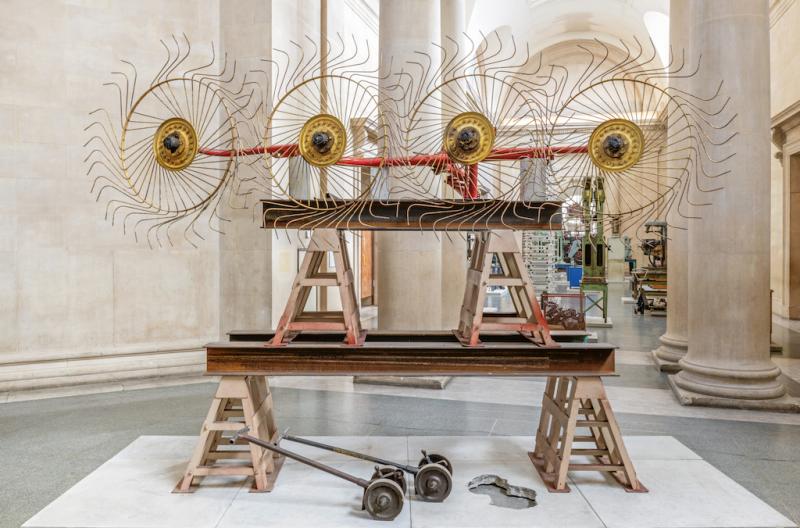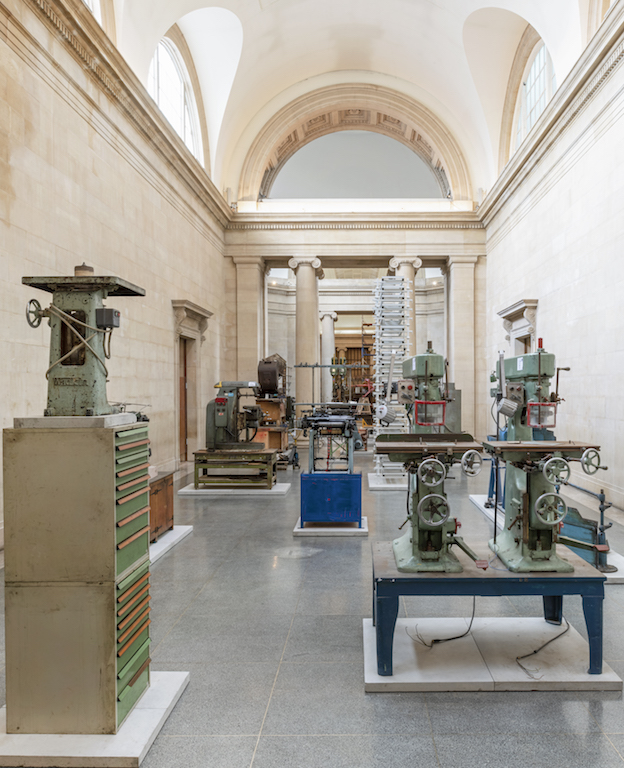Mike Nelson, The Asset Strippers, Tate Britain review – exhilarating reminder of industrial might | reviews, news & interviews
Mike Nelson, The Asset Strippers, Tate Britain review – exhilarating reminder of industrial might
Mike Nelson, The Asset Strippers, Tate Britain review – exhilarating reminder of industrial might
A stirring elegy to Britain's industrial past

Mike Nelson has turned the Duveen Galleries into a museum commemorating Britain’s industrial past (pictured below right). Scruffy workbenches, dilapidated metal cabinets and stacks of old drawers are pressed into service as plinths for the display of heavy duty machines.
The experience is exhilerating yet profoundly melancholic. The exhibition pays tribute to people like Nelson’s grandfather and parents, who worked in the textile factories of the East Midlands and whose labour once made Britain rich and powerful. The factories were closed down in the 1970s and ‘80s, but the installation is not simply a trip down memory lane, since it makes ironic reference to the source of the wealth that enabled museums like the Tate to be built. Funded by Lord Duveen, who made his fortune selling art to rich industrialists, these galleries were built in 1937 specifically for the display of monumental sculptures, so what better place to show the machines that indirectly paid for the building ?
Nelson bought the plant in online auctions run by companies who specialise in liquidating the assets of defunct businesses – The Asset Strippers referred to in the exhibition title. His purchases highlight the shift from heavy industry to the provision of services that characterises our economy in the digital age. Instead of making things, we make money – in various ways, including selling off the spoils from our past.
 There’s also some agricultural machinery (main picture), a huge caterpillar tyre, giant weighing machines and fork lifts, all of which recall the postwar era in which Nelson grew up. Access to the galleries is through dilapidated swing doors salvaged from an old hospital; there’s flooring from a former army barracks and a stack of metal sheets used to board up the windows of a housing estate earmarked for redevelopment. Emblematic of the welfare state and the ethos that brought it into being, these relics and their state of dereliction are like metaphors for the slow decline of the public sector fostered by Thatcher’s corrosive beliefs that greed is good and “there’s no such thing as society.”
There’s also some agricultural machinery (main picture), a huge caterpillar tyre, giant weighing machines and fork lifts, all of which recall the postwar era in which Nelson grew up. Access to the galleries is through dilapidated swing doors salvaged from an old hospital; there’s flooring from a former army barracks and a stack of metal sheets used to board up the windows of a housing estate earmarked for redevelopment. Emblematic of the welfare state and the ethos that brought it into being, these relics and their state of dereliction are like metaphors for the slow decline of the public sector fostered by Thatcher’s corrosive beliefs that greed is good and “there’s no such thing as society.”
The timing of the exhibition is remarkably apt. Coinciding with our proposed exit from the EU which, if it happens, will reshape our economy in unforeseen ways, the installation is like a portent of things to come. As the Chinese curse goes: “May you live in interesting times.”
One of Mike Nelson’s machine-sculptures should be installed permanently in Parliament Square as a monument to Britain’s erstwhile prowess as an industrial nation – when we were a force to be reckoned with.
- Mike Nelson, The Asset Strippers at Tate Britain until 6 October
- Visual arts reviews on theartsdesk
rating
Explore topics
Share this article
The future of Arts Journalism
You can stop theartsdesk.com closing!
We urgently need financing to survive. Our fundraising drive has thus far raised £49,000 but we need to reach £100,000 or we will be forced to close. Please contribute here: https://gofund.me/c3f6033d
And if you can forward this information to anyone who might assist, we’d be grateful.

Subscribe to theartsdesk.com
Thank you for continuing to read our work on theartsdesk.com. For unlimited access to every article in its entirety, including our archive of more than 15,000 pieces, we're asking for £5 per month or £40 per year. We feel it's a very good deal, and hope you do too.
To take a subscription now simply click here.
And if you're looking for that extra gift for a friend or family member, why not treat them to a theartsdesk.com gift subscription?
more Visual arts
 'We are bowled over!' Thank you for your messages of love and support
Much-appreciated words of commendation from readers and the cultural community
'We are bowled over!' Thank you for your messages of love and support
Much-appreciated words of commendation from readers and the cultural community
![SEX MONEY RACE RELIGION [2016] by Gilbert and George. Installation shot of Gilbert & George 21ST CENTURY PICTURES Hayward Gallery](https://theartsdesk.com/sites/default/files/styles/thumbnail/public/mastimages/Gilbert%20%26%20George_%2021ST%20CENTURY%20PICTURES.%20SEX%20MONEY%20RACE%20RELIGION%20%5B2016%5D.%20Photo_%20Mark%20Blower.%20Courtesy%20of%20the%20Gilbert%20%26%20George%20and%20the%20Hayward%20Gallery._0.jpg?itok=7tVsLyR-) Gilbert & George, 21st Century Pictures, Hayward Gallery review - brash, bright and not so beautiful
The couple's coloured photomontages shout louder than ever, causing sensory overload
Gilbert & George, 21st Century Pictures, Hayward Gallery review - brash, bright and not so beautiful
The couple's coloured photomontages shout louder than ever, causing sensory overload
 Lee Miller, Tate Britain review - an extraordinary career that remains an enigma
Fashion photographer, artist or war reporter; will the real Lee Miller please step forward?
Lee Miller, Tate Britain review - an extraordinary career that remains an enigma
Fashion photographer, artist or war reporter; will the real Lee Miller please step forward?
 Kerry James Marshall: The Histories, Royal Academy review - a triumphant celebration of blackness
Room after room of glorious paintings
Kerry James Marshall: The Histories, Royal Academy review - a triumphant celebration of blackness
Room after room of glorious paintings
 Folkestone Triennial 2025 - landscape, seascape, art lovers' escape
Locally rooted festival brings home many but not all global concerns
Folkestone Triennial 2025 - landscape, seascape, art lovers' escape
Locally rooted festival brings home many but not all global concerns
 Sir Brian Clarke (1953-2025) - a personal tribute
Remembering an artist with a gift for the transcendent
Sir Brian Clarke (1953-2025) - a personal tribute
Remembering an artist with a gift for the transcendent
 Emily Kam Kngwarray, Tate Modern review - glimpses of another world
Pictures that are an affirmation of belonging
Emily Kam Kngwarray, Tate Modern review - glimpses of another world
Pictures that are an affirmation of belonging
 Kiefer / Van Gogh, Royal Academy review - a pairing of opposites
Small scale intensity meets large scale melodrama
Kiefer / Van Gogh, Royal Academy review - a pairing of opposites
Small scale intensity meets large scale melodrama
 Jenny Saville: The Anatomy of Painting, National Portrait Gallery review - a protégé losing her way
A brilliant painter in search of a worthwhile subject
Jenny Saville: The Anatomy of Painting, National Portrait Gallery review - a protégé losing her way
A brilliant painter in search of a worthwhile subject
 Abstract Erotic, Courtauld Gallery review - sculpture that is sensuous, funny and subversive
Testing the boundaries of good taste, and winning
Abstract Erotic, Courtauld Gallery review - sculpture that is sensuous, funny and subversive
Testing the boundaries of good taste, and winning
 Edward Burra, Tate Britain review - watercolour made mainstream
Social satire with a nasty bite
Edward Burra, Tate Britain review - watercolour made mainstream
Social satire with a nasty bite
 Ithell Colquhoun, Tate Britain review - revelations of a weird and wonderful world
Emanations from the unconscious
Ithell Colquhoun, Tate Britain review - revelations of a weird and wonderful world
Emanations from the unconscious

Add comment